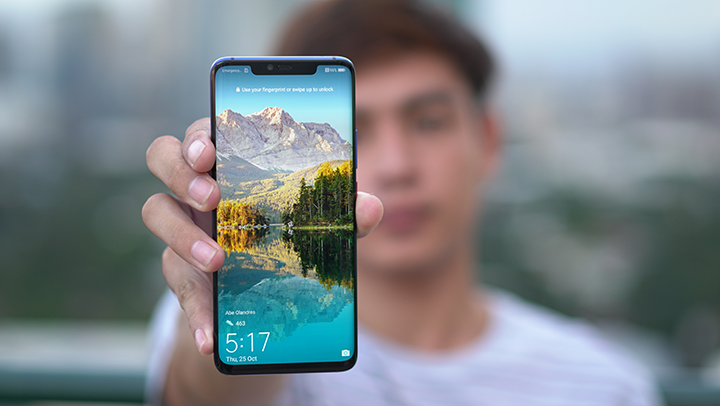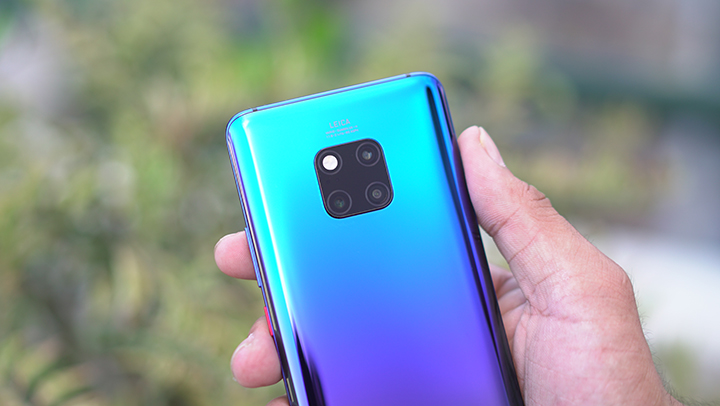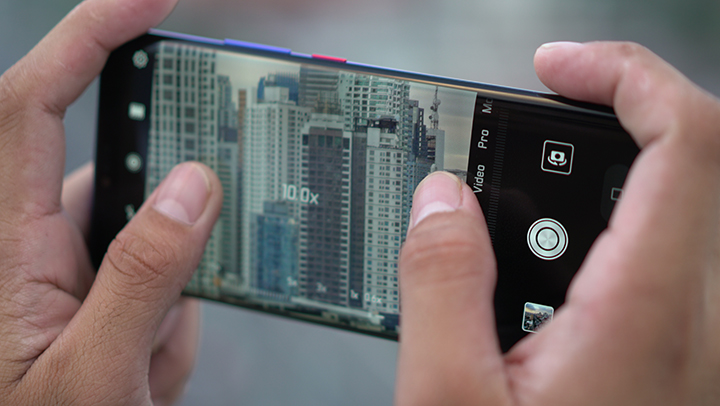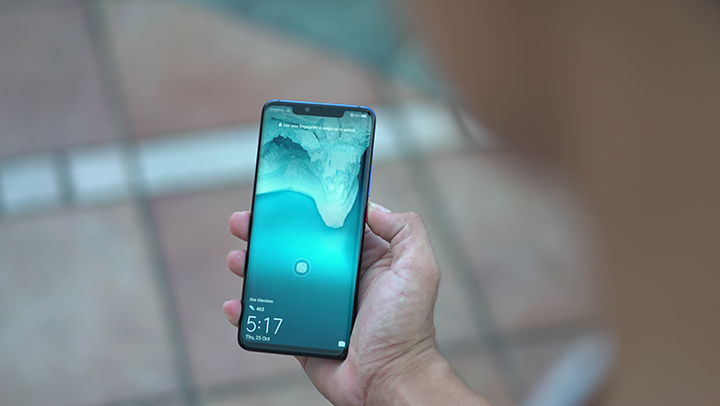Huawei is serious in becoming a top smartphone brand and it definitely shows in their flagship devices like the P20 and the Mate 20 series. With the announcement of the Mate 20, Mate 20 Pro and the Mate 20 X, it’s going to be tougher to figure out which smartphone drives the best value to customers.
The Mate 20 Pro is the hero device of the lot and is packed with almost all imaginable features one can think of from a flagship smartphone.

So it is no wonder this model is the highlight of the series and we’re giving you our verdict in this full review.
Table of Contents
Huawei went back to the drawing board and re-imagined the design of the Mate 20 Pro. There’s not much semblance from the old Mate series but more like an improvement of the existing P20 Pro, which is good.

The body is completely covered with glass from the front all the way to the back with curved sides up front and tapered sides at the back for a better and more comfortable grip. Huawei has not indicated if it’s using Gorilla Glass this time but maybe it’s the same one used with the P20 Pro.

Because of the curved edges, we’re forced to compare it with the Galaxy S9 and the semblance is undoubtedly pretty close. Of course, there’s that very wide notch on the Mate 20 pro that is non-existent on the Galaxy S9 so the latter has that slight design/engineering advantage.

We especially liked the Twilight color at the back that starts from an ocean green colors to purple to dark blue. The colors change a bit as light hits it at different angles. Light reflects nicely off the back of midnight blue and emerald green making the unique Hyper Optical Patterns glitter, a special glass texture that is both non-slip and anti-fingerprint.
The device is completely covered in some scratch-resistant glass though we are not certain if Huawei used Gorilla Glass for protection this time around.

Like the P20 Pro, the Mate 20 Pro also now has an IP68 rating which means it can go underwater for up to 1.5 meters and as long as 30 minutes. There is no 3.5mm audio port, a trend that has been going on now for about a year. Huawei included a Type-C to 3.5mm adaptor when you need to still plug it to external speakers and the included earphones now plug to the USB port.
The Mate 20 Pro sports a 6.39-inch OLED display with a 2K+ (1440 x 3120 pixels) resolution that gives it a nice 538ppi pixel density. The 19.5:9 makes the device look taller than wider and the high 87.6% screen-to-body ratio is the result of narrower bezels and the entire front panel dedicated to the display.

Of course, there’s still that controversial notch which is ironically much wider than that of the P20 Pro and even more compared to the Mate 20 sibling. This is due to the additional sensors that were placed alongside the front-facing camera that took a lot more space than usual.

It’s also worth noting that the Mate 20 has a larger display compared to the Mate 20 Pro, going against the norm. This happened with the Mate 10 series as well and we’re not particularly sure what the reason behind that.
The curved edges do not really add any functionality, unlike the Galaxy S and Note series. However, it makes the device easier to hold despite its size. The bezels are narrower and the curved edges make it seem like the display is almost flowing towards the corners.

Huawei isn’t the first one to implement an in-screen fingerprint sensor (that distinction belongs to VIVO) but they sure did a good job in making it accurate and responsive. There seems to be very little to negligible delay when using the fingerprint sensor and it is placed just in the right place where you can easily reach it without any trouble.

Facial recognition is equally good and fast. Enrolment is easy and can be done in less than 10 seconds and you have several options for added security like options for requiring direct eye contact to recognize, direct unlock or add an extra step like sliding the screen before unlocking the screen.
As for multimedia features, the Mate 20 Pro continues to have a built-in IR blaster that serves as a remote control for home appliances. This is perhaps one of the best features of the phone that we don’t often see in any other flagship phones.

Likewise, the Mate 20 Pro comes with dual speakers placed at both ends of the device, allowing it to produce really good sound quality even at very high volume. The stereo speakers aren’t new but the ones implemented by Huawei are “invisible”, allowing it to retain its IP68 rating.
Like the previous Mate series, the Mate 20 Pro is capable of directly connecting to an external display or monitor using its USB Type-C 3.1 port using an HDMI cable. There’s also an optional wireless dongle that (bought separately) that can make this connection to an external display wirelessly.
Huawei made some drastic changes in their triple-camera system. It used to be highlighted by a monochrome sensor, first introduced in the P9 with Leica optics. With the Mate 20 series, the monochrome sensor is gone and now been replaces by an ultra-wide angle camera.

So now you have a 40MP hi-res wide-angle camera, an ultra-wide angle, and a telephoto camera.
Also worth noting that the placement of the camera at the back is a squarish layout in the middle, a stark contrast of the P20 Pro which is flushed to the left in one single row.

Huawei purposely made this to create a design distinction between the P series and the Mate series.
The three cameras are placed in a large housing with the dual-tone, dual-flash to fill the squarish layout.

The rationale behind the shift to an ultrawide angle camera in lieu of the monochrome sensor is that the new sensor used by Huawei is large and powerful enough to gather the same image detail that the monochrome sensor used to provide. This replaced the need for a dedicated monochrome sensor.

Of course, there’s a compromise but Huawei believes that consumers will benefit more and enjoy a camera system with an option for an ultra wide-angle camera. And we agree.
Like the P20 Pro, optical zoom goes up to 5x and digital zoom is up to 10x.

Likewise, the ultra-wide-angle camera is capable of capturing images as close as 2.5cm, effectively allowing for macro shots to be taken by the lens. That’s another feature on the plus side.
Overall, the shift to this new camera system makes the Mate 20 Pro a more versatile photography device.
Here’s a sample selfie shot from the front camera:
Using the portrait mode of the rear camera:

More sample photos from our trip in London:
Huawei has incorporated Master AI into the main camera that automatically selects the best shooting mode based on the settings or environment. This means you get the best possible image whenever you take your photos.
The main camera is able to record videos of up to 4K UHD at 30fps or full HD at 60fps. It also supports H.265 encoding that uses smaller files for lower storage requirements.
Overall, the camera of the Mate 20 Pro is nothing short of superb. It’s crisp, accurate and captures a lot of details. The zoom feature is something we don’t see anywhere else and with the new ultra-wide lens, you get more creative options for shooting.
The Mate 20 Pro comes with Android 9.0 Pie right out of the box. Huawei complimented this with their very own EMUI 9 as well so there are a lot of tweaks and custom features native to the Mate 20 series. EMUI has certainly matured compared to the previous versions. It’s lean and well-optimized with options for a lot of themes that you can download to change the look and feel of the interface to your liking.

Since it has Android 9, there are new features incorporated into the software that extends the capability of the device.
Huawei has added a lot of productivity features and other software features that are both useful and practical. Among them are the App Twin (two instances of apps like FB Messenger, WhatsApp, etc), option for Private Space as a second and completely separate working space from the Main Space, Huawei Share, Wireless Projection, and Smart Assistance for one-handed UI, motion control and voice control.

There are some apps pre-installed in the device, including a native Health app, Smart Remote, Hi Care and a Phone Clone app that is very useful when you want to transfer the contents and settings of your old phone to your new Mate 20 Pro (works flawlessly with Huawei phones but supports other Android and iOS devices).
The 128GB storage is already a lot but there’s the NM card slot should you wish to add more storage of up to 256GB.
The Mate 20 series is the first to sport the HiSilicon Kirin 980 chipset that uses an architecture consisting of two super-big, high-performance cores based on Cortex-A76 to handle immediate, intensive workloads; two big, high-efficiency cores based on Cortex-A76 to for sustained performance; and four little, ultra-efficiency based on the Cortex-A55 to tackle everyday, light activities.

In addition, it also runs on higher clock speeds compared to the prior generation for quicker app launch times, better multi-tasking, and smoother user experience.
The graphics is handled by Mali-G76 GPU which offers 46% greater processing power and 178% improved power efficiency over the Kirin 970’s Mali-G72. It also features a clock boosting technology that utilizes AI to intelligently identify gaming workloads and adjust resource allocation for optimal gaming performance.

Gaming experience is undoubtedly very good especially with the performance boost and the large OLED display.
So we ran the new Mate 20 Pro thru several of our standard benchmarks and this is what we got:

The Mate 20 Pro’s Antutu score tops at 273,233 which is among the highest we’ve seen. This is about 33% higher than the score of the Kirin 970 in the Huawei P20 Pro.

For PCMark, we saw a significant increase in benchmark scores as well. It’s perhaps in AndroBench were the scores of the internal storage are the same as the old ones in the P20 Pro so we reckon it might be just the same parts used.

We also saw a huge jump in performance scores using GeekBench 4.2, going as high as 9,831 for the multi-core score.
• Antutu Benchmark: 308,999
• PCMark: 13,584 (Work 1.0), 9,238 (Work 2.0)
• 3DMark: 4,226 (Sling Shot Extreme, Open GL 3.1), 4,245 (Sling Shot Extreme, Vulcan)
• GeekBench 4: 3,295 (Single Core), 9,831 (Multi-Core)
• AndroBench: 824 MB/s (Read), 194 MB/s (Write)
Do take note that these benchmark tests were taken when Performance Mode has been enabled. Performance Mode allows the device to perform at its peak level but for a shorter period as it tends to stress the CPU/GPU and generates more heat.
Huawei phones have very good signal quality and reception. This is equally true with the Mate 20 Pro. Very strong LTE/LTE+ signal, great WiFi reception as well as call quality, thanks to multiple antennas surrounding the device.
The Mate 20 Pro supports a dual nano-SIM cradle with the second SIM tray capable of handling a new and much smaller NM card with capacities of up to 256GB.

As for connectivity, the phone has got everything you’d want — NFC, Bluetooth 5.0, dual-band WiFi and the fastest LTE Cat. 21 modem (the modem is also 5G-ready). It also has dual-GPS (Glonass, BeiDou, Galileo [E1 + E5a dual band], QZSS), the first in any flagship phone for much higher accuracy even in the urban jungle where skyscrapers abound and block the satellite signal. The Mate 20 Pro is the world’s first 1.4Gbps LTE Cat.21 smartphone which supports up to 1733Mbps of mobile data transfer.

Equipped with a large 4,200mAh battery, the Mate 20 Pro has one of the largest battery capacities in the flagship market. It can last you an entire day even with heavy use and well over a day in moderate use. In our video loop test, we managed to get 23.5 hours of video playback on a single full charge, among the longest we’ve tested in the hundreds of smartphones that goes thru our review process.
Using our standard test using PCMark Battery test, the Mate 20 Pro scored 10 hours and 28 minutes at 50% brightness, zero volume and in airplane mode.

One of the more unique features of the Mate 20 Pro is that it is capable on providing reverse wireless charging, meaning it can wirelessly recharge other smartphones that support wireless charging, like the Galaxy S9, Note9, LG G7, iPhone X, Xs, and Xs Max. That’s a first in the industry and something that might come in handy with people who lugs more than one phone around.
The included 40W Huawei SuperCharge allows the device to charge up to 70% in just 30 minutes, although a full charge from zero to 100% will still need somewhere around 70 minutes to fully complete. That’s still a feat considering the large 4,200mAh battery.
In the past couple of years, the Huawei P series seems to be the more prominent device among its stable of flagship smartphones but this year it looks like the Mate series, specifically the Mate 20 Pro will get the most attention from Huawei’s line-up.

The Mate 20 Pro is a huge upgrade compared to its predecessor and definitely a strong contender amongst high-end flagship phones this year. It packs everything one would wish for from a flagship smartphone and some more. We could not find anything we did not like about it. Well, except for that very high price tag.

Overall, Huawei has done a great job with the Mate 20 Pro. It’s gorgeouos, very powerful, shoots awesome photos and lasts more than a day on a single full charge. There’s nothing more you could ask for.
| Huawei Mate 20 Pro | |
|---|---|
| Display | 6.39" 19.5:9 OLED, 2K+ (1440 x 3120), 538ppi, 87.6% screen-to-body ratio |
| CPU | Kirin 980 2.6GHz octa-core processor (2x Cortex A76 2.6GHz + 2x Cortex A76 1.92GHz + 4x Cortex A55 1.8GHz) |
| GPU | Mali-G76 MP10 |
| RAM | 6GB, 8GB |
| Storage | 128GB, 256GB |
| Expandable storage | up to 256GB via NM card |
| Rear camera | 40MP (Wide Angle Lens, f/1.8) + 20MP (Ultra Wide Angle Lens, f/2.2) + 8MP (Telephoto, f/2.4) Leica Triple cameras, AI Stabilization |
| Front camera | 24MP, f/2.0, 3D Depth Sensing |
| Camera Features | ~ Underwater shooting mode ~ AI portrait color mode ~ 3D Depth Sensing Mode |
| SIM | Dual SIM |
| LTE | 4G LTE Cat. 21 |
| Wi-Fi | WiFi 802.11 a/b/g/n/ac (wave2), 2.4GHz and 5GHz |
| Bluetooth | Bluetooth 5.0, BLE, SBC, AAC, aptX, aptX HD, LDAC and HWA Audio |
| GPS | Dual GPS, AGPS, Glonass, BeiDou, Galileo (E1 + E5a dual band), QZSS |
| NFC | Yes |
| Biometrics | ~ In-screen fingerprint scanner ~ 3D Face Unlock |
| 3.5mm audio port | n/a |
| IR Blasters | Yes |
| Features | ~ IP68 resistance ~ Invisible Dual speakers ~ App Twin ~ Google AR Core ~ 3D Live Emojis |
| USB | USB Type-C 3.1 |
| Battery | ~ 4,200mAh battery with SuperCharge ~ Wireless Charging Support ~ Wireless Reverse Charging |
| OS | EMUI 9.0 (Android 9.0 Pie) |
| Dimensions, Weight | 157.8 x 72.3 x 8.6 mm, 189 g |
| Color | Emerald Green, Midnight Blue, Classical Black, Twilight, Pink Gold |
What we liked about it:
* Beautiful curved display
* Impressive performance
* Very nice design and build quality
* Great camera system
* Very long battery life
What we did not like:
* On the very expensive side
Check this out –> Huawei Mate 20 Pro vs. Samsung Galaxy Note 9 Comparison Review

YugaTech.com is the largest and longest-running technology site in the Philippines. Originally established in October 2002, the site was transformed into a full-fledged technology platform in 2005.
How to transfer, withdraw money from PayPal to GCash
Prices of Starlink satellite in the Philippines
Install Google GBox to Huawei smartphones
Pag-IBIG MP2 online application
How to check PhilHealth contributions online
How to find your SIM card serial number
Globe, PLDT, Converge, Sky: Unli fiber internet plans compared
10 biggest games in the Google Play Store
LTO periodic medical exam for 10-year licenses
Netflix codes to unlock hidden TV shows, movies
Apple, Asus, Cherry Mobile, Huawei, LG, Nokia, Oppo, Samsung, Sony, Vivo, Xiaomi, Lenovo, Infinix Mobile, Pocophone, Honor, iPhone, OnePlus, Tecno, Realme, HTC, Gionee, Kata, IQ00, Redmi, Razer, CloudFone, Motorola, Panasonic, TCL, Wiko
Best Android smartphones between PHP 20,000 - 25,000
Smartphones under PHP 10,000 in the Philippines
Smartphones under PHP 12K Philippines
Best smartphones for kids under PHP 7,000
Smartphones under PHP 15,000 in the Philippines
Best Android smartphones between PHP 15,000 - 20,000
Smartphones under PHP 20,000 in the Philippines
Most affordable 5G phones in the Philippines under PHP 20K
5G smartphones in the Philippines under PHP 16K
Smartphone pricelist Philippines 2024
Smartphone pricelist Philippines 2023
Smartphone pricelist Philippines 2022
Smartphone pricelist Philippines 2021
Smartphone pricelist Philippines 2020
WilliamC says:
The notch is not a disadvantage for the Mate 20Pro as you could hide it in settings and whichever way you use it, it you increase the screen to body ratio of the phone, more than the S9.
henrydevid says:
Actually, I have already used it so for that if you interested with it then you will know it from getting some review. And from further about it epson error code 0x97 just visit with it .
Kevin Ongoco says:
Hello, have you covered about the green tint issue/ bleeding in the screen of huawei mate 20 pro?
Johnette says:
Tht’as going to make things a lot easier from here on out.
Cel says:
What is the best screen protector for Huawei Mate 20 Pro?